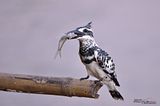May 11, as I was observing a pair of a male and female Greater Painted-Snipes (Rostratula benghalensis) at Sekinoe, Furuso-san came by and showed me photos of a Kentish Plover chick she surprisingly found at Mochigahama beach the day before. I've never seen a plover chick before, so I was very excited and wanted to head to Mochigahama right away, but unfortunately it was already too dark. I had to wait until May 13, when I finally had enough free time to go and look for the plover chick. As soon as I arrived at the place where she found the chick, I suddenly heard a distinct whistling call. I looked around and finally spotted a male Kentish Plover (Charadrius alexandrinus nihonensis) standing still giving its call from the top of the rock. I knew right then that the chick must be somewhere near, but it's too difficult for me to find the chick by myself, so I stepped back and observed the adult bird. The adult kept calling for a short moment, then a tiny object came moving rapidly along the dirty rocks. Yes, it was the chick!
 Kentish Plovers in Japan seem to be much paler than the ones I normally saw in Thailand. As suggested by Dave Bakewell in this post, the ones occur in Japan are the race C.a.nihonensis, while the ones in Thailand are the nominate 'alexandrinus' race. This male here is especially pale, almost as pale as the recently split White-faced or Swinhoe's Plover (Charadrius dealbatus), except for its distinct black lores. Its breastpatches are thin and short, and its eyestripes are faint. It looks almost like a combination between the male Kentish (C.a.alexandrinus) and Swinhoe's Plover in the photo taken in Thailand by Smith Sutibut below.
Kentish Plovers in Japan seem to be much paler than the ones I normally saw in Thailand. As suggested by Dave Bakewell in this post, the ones occur in Japan are the race C.a.nihonensis, while the ones in Thailand are the nominate 'alexandrinus' race. This male here is especially pale, almost as pale as the recently split White-faced or Swinhoe's Plover (Charadrius dealbatus), except for its distinct black lores. Its breastpatches are thin and short, and its eyestripes are faint. It looks almost like a combination between the male Kentish (C.a.alexandrinus) and Swinhoe's Plover in the photo taken in Thailand by Smith Sutibut below.


Male Kentish Plover



Best attempt to camouflage. Not working? Then run!
After the chick finally showed up, it became very easy for me to take photos. The only thing I needed to concentrate on is the chick. I had to focus on it wherever it ran to, otherwise I would lose both the chick and the parent. The chick was extremely cute. When I got too close it would just stayed still as if it was dead. It always tried to run to the closest object that looked similar to its plumage, like stones or washed up seaweed. If I stepped back a little and sat still for a moment, it would slowly rose up and quickly ran off as fast as possible. It was entertaining for me to watch the adult running along with the chick looking for food along the beach. I always made sure that they were together before I left the place. Both of them have already left the beach now. I hope that they are doing well somewhere along the coastline of Beppu.





Male assuming breeding plumage Greater Sand Plover (Charadrius leschenaultii)
Apart from the cute pair of Kentish Plovers, Mochigahama beach also offered a nice male moulting into breeding plumage Greater Sand Plover (Charadrius leschenaultii). The bird was first found on the evening of May 13, and stayed for a few days later. It was a bit sad that the bird was still on its way moulting into breeding plumage. It'd be wonderful if it's already fully moulted. About a week before I found this bird, a pair of Lesser Sand Plovers was also found at Rokushou-en. One of the bird was also in its breeding plumage and it looked very beautiful. Another one was still in its non-breeding plumage though. I kinda regretted that I didn't check the Oita Birds website earlier. By the way, the Greater Sand Plover is a better find though, as it is much scarcer than the Lesser Sand here in Japan. Both of them are numerous in Thailand, but the chances to get close to them are very few.





















.jpg)

5 comments:
A great set of pictures Ayuwat, and as you say they really show how pale but super-smart the Japanese Kentish is.
Some nice Plover shots there and how cute is that chick??????
Really stunning photographs and cute plovers.
Interesting to see the nihonensis KP...and I find it always useful to look at the structure of non-breeding sandplovers !
Do you have any more shots of the juveniles... I still -even with a lot of help- haven't worked out my 31 May HK bird !
Thanks for all the comments!
John> Unfortunately, I don't have any more photos of the juvenile in elder stages, since I dropped my camera into the mud shortly after that. I went back again a week ago, but the bird wasn't there anymore....
Post a Comment